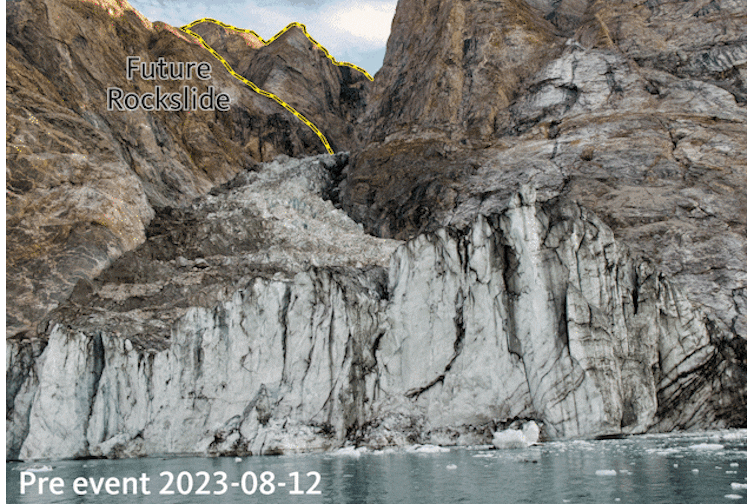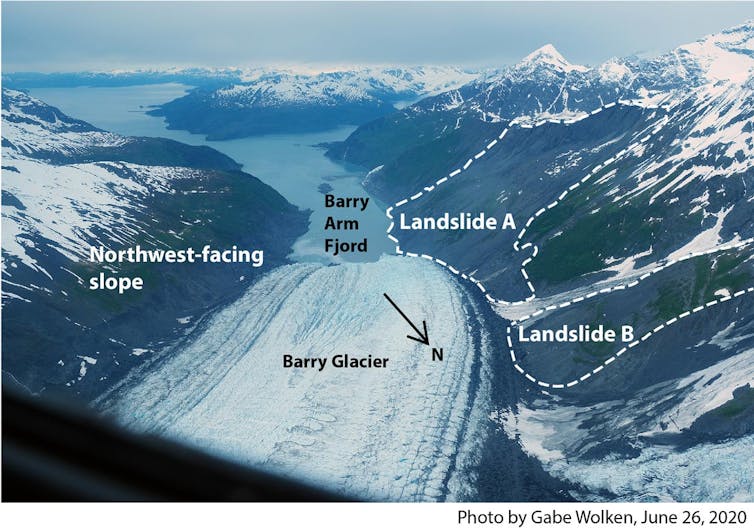Earthquake scientists have detected an unusual signal at observatories to record seismic activity in September 2023. We observe it in sensors all over the world, from the Arctic to Antarctica.
We were confused: the signal was unlike anything recorded before. Instead of the frequency-filled rumble typical of earthquakes, it was a dull rumble with a resonant frequency. The fact that the signal stayed the same for nine days was even more disconcerting.
 Dickson Fjord is surrounded by rugged mountains.
Dickson Fjord is surrounded by rugged mountains.Initially classified as a USO (unidentified seismic object), the source of the signal was eventually located in a massive landslide in Greenland's remote Dixon Fjord. Enough rock and ice to fill 10,000 Olympic-sized swimming pools rushed into the fjord, triggering a 200-meter-high megatsunami and a phenomenon known as a seiche: a wave constantly regurgitating a frozen fjord. And, about 10,000 times in nine days.
In the wake of the tsunami, that 200-meter wave was twice as tall as London's Big Ben and several times taller than those recorded after a massive underwater earthquake in Indonesia in 2004 (Boxing Tsunami Day) or Japan in 2011 (the tsunami that hit the Fukushima nuclear power plant). It may be the highest tide anywhere on Earth Since 1980.
Our findings, recently published in the journal ScienceA further 66 scientists from 40 institutions in 15 countries collaborated. As with the investigation of a plane crash, solving this mystery requires gathering a variety of sources, from abundant seismic data to satellite images, measurements of water levels in fjords, and detailed simulations of evolution. Tsunami wave.

Front: Wieter Boon / Flanders Marine Institute; Back: Danish Army
All of this unleashed a catastrophic series of events, decades to seconds before the collapse. The landslide descended into a narrow valley on a very steep glacier before plunging into a narrow, confined fjord. Eventually, however, decades of global warming thinned the glacier by tens of meters, so that the mountain that towered above it no longer stood.
Unspecified water
But beyond the rarity of this scientific miracle, the phenomenon underscores a deeper, more disturbing truth: Climate change is reshaping our planet and our scientific methods in ways we're only beginning to understand.
A stark reminder that we are navigating uncharted waters. A year ago, the idea that a seach could last nine days would have been dismissed as absurd. Likewise, a century ago, the idea that warming would destabilize the slopes of the Arctic and cause large landslides and tsunamis almost every year was considered far-fetched. However, these are becoming once unthinkable events New Reality.
As we move into this new era, we can expect many events that challenge our previous understanding because our experience does not encompass the extreme conditions we now face. We found an unimaginable nine-day wave.
Traditionally, discussions of climate change have focused on looking above and beyond the atmosphere and oceans, along with changes in weather and sea levels. But Dixon Fjord forces us to look down at the crust beneath our feet.
Perhaps for the first time, climate change has triggered a seismic event with global implications. A landslide in Greenland shook the earth, shaking the planet and creating seismic waves that traveled around the world an hour after the event. No ground beneath our feet is immune to these vibrations, metaphorically opening cracks in our understanding of these phenomena.
It will happen again
Although landslides associated with tsunamis have been recorded before, the first was observed in September 2023 in East Greenland, an area that is particularly resistant to catastrophic climate change-induced events.
It certainly won't be the last megatsunami of its kind. As permafrost on steep slopes continues to warm and glaciers thin, these events can be expected to occur. More often and on a larger scale In all polar and mountainous regions of the world. Transient slopes have recently been identified West Greenland And inside Alaska They are clear examples of disasters to come.

Cape Volcan/USGS
As we face these extreme and unpredictable events, it is clear that our current scientific methods and tools may require further development to cope. We do not have a standard workflow for analyzing the 2023 Greenland event. We also need to adopt a new mindset, because our current understanding is shaped by a stable climate and is now almost extinct.
As we continue to alter our planet's climate, we must be prepared for unexpected events that challenge our current understanding and demand new ways of thinking. The ground shakes under our feet, literally and figuratively. While the scientific community must adapt and prepare to make informed decisions, policymakers must act.
Stephen HicksResearch Fellow in Computational Seismology, UCL And Christian SvennevikSenior Researcher, Department of Mapping and Mineral Resources, Geological Survey of Denmark and Greenland
This article was originally published Conversation. Read on Original.
Independent journalism needs the support of its readers to continue and uncomfortable stories you don't want to read are within your purview. Today, with your support, we will continue to work for censorship-free journalism!
Support El Nacional




:quality(75)/cloudfront-us-east-1.images.arcpublishing.com/elcomercio/VCSWMDHFFBBC5F5XAUWVIHBHHM.jpg)
